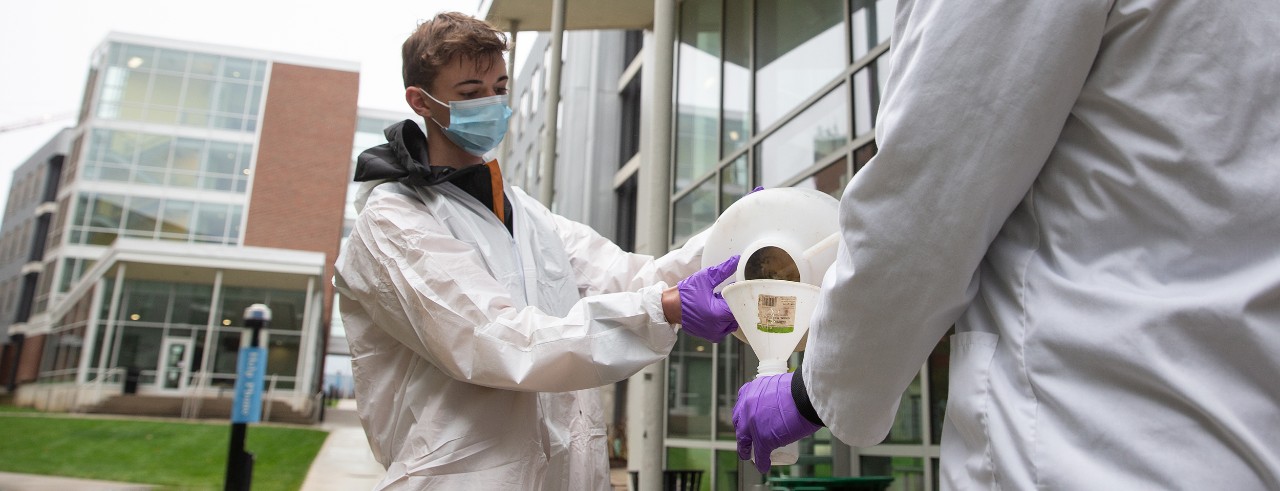
Engineering students help track pandemic in Ohio
UC’s surveillance program has helped to keep COVID-19 in check on campus, professor says
The COVID-19 pandemic has had a staggering toll — nearly 7 million people dead, including more than 1.1 million in the United States alone.
Nationwide, health officials have documented 103 million cases of COVID-19 since the pandemic began in early 2020. And many survivors are still grappling with health issues related to their infection, known as long COVID-19.
As bad as that was, it could have been worse, University of Cincinnati Associate Professor David Wendell says.
For the past three years, he and his environmental engineering students have been participating in Ohio’s COVID-19 surveillance system, testing wastewater on campus to identify infections among students living in UC’s dorms and taking steps to prevent spikes in cases from spreading across campus.
Wendell said an early bout with COVID-19 in 2020 before vaccines were available made him appreciate how debilitating the disease can be.
“I had a really bad case,” he said. “I felt that if I could prevent one student from going home and infecting their parents, it would all be worth it.”

Biomedical engineering students are helping the Ohio Health Department monitor COVID-19 on campus as part of a surveillance program. Photo/Andrew Higley/UC Marketing + Brand
Wendell’s lab in UC’s College of Engineering and Applied Science invested in the equipment needed to amplify DNA, one of the steps epidemiologists use to identify new strains of the disease. He volunteered to work with Ohio’s Department of Health to monitor cases on campus through grants from the Centers for Disease Control and Prevention.
“At the time, people were scared,” he said. “We started the surveillance right when the pandemic began.”
You know they have COVID before they do.
David Wendell, UC Biomedical Engineering Professor
Several times a week, students fan out across campus in latex gloves, clean room garb and eye protection to collect wastewater samples. Special pumps beneath manhole covers collect small samples of wastewater at regular intervals during the day to capture longitudinal data about the population on campus, particularly those living in the dorms.
“One of the biggest advantages of wastewater surveillance is to pick up the virus in the population before people are even symptomatic,” said Wendell, who holds a joint appointment in UC’s departments of biomedical engineering and chemical and environmental engineering.
“So you know they have COVID before they do,” he said.
During the pandemic, UC’s surveillance program on at least one occasion helped health officials such as Dr. Dustin Calhoun, the lead medical contact for the program, intervene early to prevent an observed increase in cases in one dorm from spreading across campus, Wendell said.
The program is sponsored by the Ohio Department of Health.
“We were able to identify a cluster of students who quarantined right before summer break last year to keep other people from getting sick. I think it made a difference,” Wendell said.
So far this fall, environmental engineering students are finding very little COVID-19 activity on campus in their lab tests.
“This year we’ve mostly only seen trace detection levels,” he said.
The surveillance program will continue through at least June.
UC student Nathan Deuitch said the public health project is what made him want to study environmental engineering.
“I find it quite exciting that I can work on a project like this as an undergraduate,” Deuitch said. “I wasn’t really expecting to be able to do much of anything in a lab as a first or second year, so doing a project of this magnitude is really neat to me.”
Featured image at top: Biomedical engineering students collect a wastewater sample on UC's Uptown campus. Photo/Andrew Higley/UC Marketing + Brand

UC College of Engineering and Applied Science Associate Professor David Wendell has joint appointments in biomedical engineering, chemical engineering and environmental engineering. Photo/Andrew Higley/UC Marketing + Brand
Next Lives Here
The University of Cincinnati is leading public urban universities into a new era of innovation and impact. Our faculty, staff and students are saving lives, changing outcomes and bending the future in our city's direction. Next Lives Here.
Related Stories
UC's art collection on display at the Contemporary Arts Center
January 5, 2026
University of Cincinnati leaders joined WVXU's Cincinnati Edition to talk about the university’s 200-year-old art collection, a new exhibition at the Contemporary Arts Center and the release of a companion book exploring the collection’s role in education and public engagement.
What's behind the mysterious rise of migraines?
January 5, 2026
Weather patterns such as extreme heat and storm conditions have been linked to migraine attacks, and research shows those environmental conditions are becoming more common. As National Geographic recently reported, one of the leading theories behind this mysterious rise is that climate change may be playing a role.
Top six 2025 nephrology drug approvals
January 5, 2026
“2025 has been a landmark year for kidney disease therapeutics, marked by a comprehensive slate of FDA approvals covering endothelin-receptor blockade, complement inhibition, GLP-1-based metabolic protection, and B-cell-directed therapy,” Prakash Gudsoorkar, MD, associate professor of clinical medicine at the University of Cincinnati College of Medicine and staff nephrologist at UC Health, recently told MedCentral.
